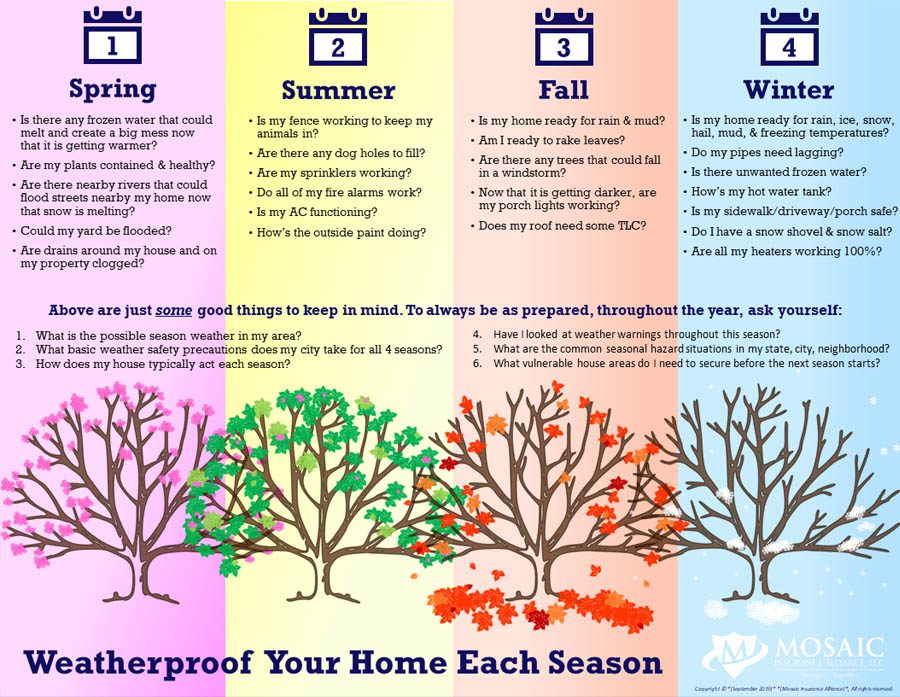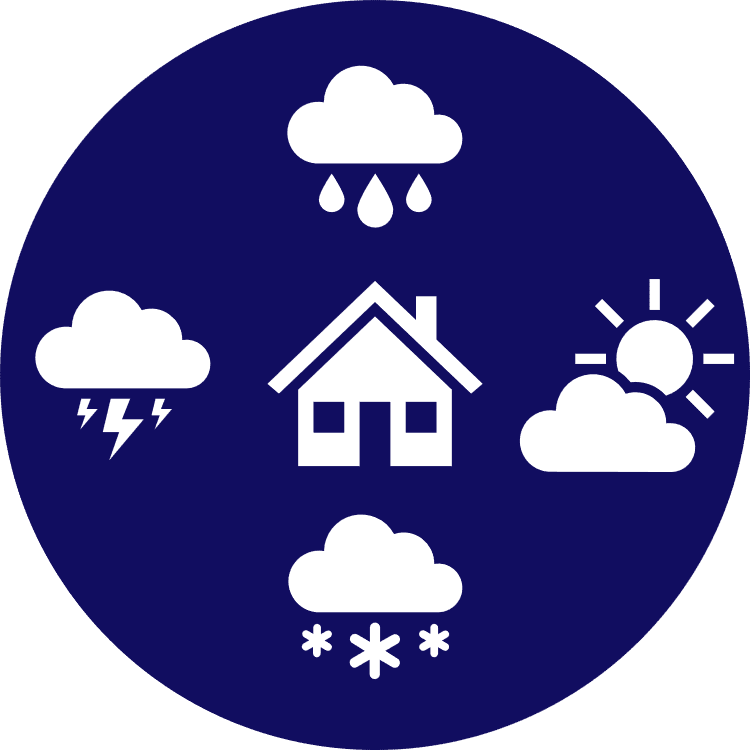More rain and colder weather are coming—are you prepared?
When you think of good home security, you might think of getting home insurance, having security cameras, always having locked doors and windows, not advertising to the whole world the expensive items you own, and avoiding burglars and house fires at any cost. Those are all great! Especially having a stable house insurance policy to back you up. But, what about that sky, Chicken Little?
The sky doesn’t have to be falling to be hazardous to your home. Tornadoes, hurricanes, and the like might not happen in your area, BUT moderate rain, wind, hail, snow, ice and other “smaller” weather conditions can be a reason for concern. In addition to getting a great home insurance policy, take safety steps to prepare against all weather conditions throughout the year.
With fall and winter really starting to make their comeback, cold weather conditions should definitely be on your radar as you are making sure that your home is protected. And, lets face it, in Washington, weather is unpredictable, and rain is like second nature. Rain defines the Washingtonian so much in fact, that many scoff at using an umbrella in the Pacific Northwest. Only real Washingtonians aren’t scared of getting wet. I bet you’ve heard, or even said, that many times before! If you subject your home to that “manning up” attitude, you might be faced with expensive repairs in the future.
After winter is over, make sure that you don’t let your guard down. All seasons come with their own baggage. For instance, summer heat can be an issue for your home. You might be happy as can be, planning a vacation and wanting to sit on the beach, but your home might not be as chipper and laid back…It might need some TLC during spring or summer, even if you live in Northern Washington where it does not get nearly as hot as other states. After winter is over, keep in mind that hot and dry weather might lead to your home needing maintenance to its air conditioning and ventilation systems. Those can be costly to repair if you don’t keep maintenance up on them. You might also need to clear brush around your home, especially if you are in a fire-risk area. Perhaps you even might have a disastrous plumbing flood in the future if your laundry system clogs with frozen water during the winter and then melts when it gets warmer outside. That huge amount of water has to go somewhere fast…Hello busted pipes and new indoor swimming pool…
Bottom line: Know the dangers of each season and how to keep your home in tip top shape against them. Need a little reminder? Use this infographic throughout the year to refresh on tips for winter, summer, spring, and fall. Hang it on your refrigerator next to your grocery list! Or, save it on your phone as calendar reminders before the change of each season (most calendar apps allow you to add an image). To save the infographic as an image, select and hold on your phone, or right click on your computer. If you want a crisper document to save and pint off, you can download the PDF here.
Ok, well…Where do I start? How do I weatherproof my home?
That depends on many factors. We recommend consulting a professional in your area for the best action steps to take. But, overall, here are some things to keep in mind that can help you create a safer home in different weather conditions:
1. Know the possible weather conditions and basic weather safety rules of your area.
- Know the common weather for your state and the part of the state that you live in.
- Be aware of weather that you could see in your area, even if it is not very often.
- For example: The Pacific Northwest does not get snow very often, but there are times where it can get 3 or more feet. It is important to take the necessary precautions before winter since…
- That area has many large hills.
- Plows are scarce.
- Main roads do not get cleared as often or well as the average driver is comfortable driving in.
- Some residential roads are not cleared by the city.
- It can take many days before a residential street is plowed (if it even is).
- The general population does not know how to drive safely in snow.
- Some have experience driving in the snow in other states but don’t know how to safely drive in the snow in this specific area. For instance, they might not be used to all the icy hills.
- Many cars are not equipped with the proper tires.
- The average person does not own the proper equipment for clearing their property and the sidewalk in front of their house.
YIKES! That is a lot of scary information there! Not being aware and preparing for all that can very likely lead to (1) you being trapped in your home without the necessary daily items like food, (2) snow sliding off a hill in your yard and causing damage when it hits your home, (3) snow caving in parts of your roof or porch, (4) pipes freezing and bursting, (5) someone falling in your icy driveway or the snowy sidewalk in front of your house and suing you for medical expenses, etc. Now that you know winter can be dangerous in Washington, how can you avoid hazards? You can consult professionals in this field, as well as look at government safety information from sources like Washington State Department of Labor and Industries and Seattle Department of Transportation. Additionally, make sure your home insurance policy is equipped to protect against hazards you’re likely to face in your area.
- How cold does it get where you live and during what time of the year? Lagging exposed pipes in a timely manner can help avoid a big headache.
- Be aware of the types of things that your city faces—i.e. which roads to avoid in certain conditions, common flood zones, city equipment availability like snow plows, etc.
- Gather all the information you can about your exact location. Knowing the neighborhood you live in can be very helpful (i.e. nearby trees that could fall, maintenance items your neighbors have that you might be able to use, dangerous actions that your neighbors commonly do like not maintaining a fence that could fall into your yard, etc.).
2. Get to know your own home inside and out.
- What does your home do when it rains a lot? Are your gutters prone to clogging?
- Are the pipes in your home on the older side and cannot handle the dishwasher, sink, shower, and laundry machine running full blast all at once?
- What are the common problems with houses on hills like yours?
3. Monitor weather warnings throughout the year.
- Local radio and TV weather stations frequently have information on what weather is coming as well as ideas on how to be ready and safe. Listen to the weather forecast on a regular basis to help buy yourself time.
- You can specifically search for more information after you hear about an upcoming weather forecast. Some good resources are national ones like The National Weather Service and Ready.gov, as well as local ones like KingCounty.gov and Washington State Department of Transportation.
4. Know what to do in common weather forecast situations/hazards.
- Have action plans if the worst happens. You need to be prepared beforehand.
- Have storage items commonly needed (food, water, flashlights, pre-charged battery banks, snow shovels, etc.) for different situations that you are likely to have happen, such as having a power outage, being snowed in, being in lockdown from hurricane watch, etc. The last thing you want to deal with is trying to get something like a snow shovel when you cannot get out of your driveway…Don’t be that person who walks up hill both ways in the snow to the nearest convenience store to find out that they are all sold out of snow shovels and no store within 20 miles has them…
- Make sure that others know their action steps and that you are able to be calm and collected. Remember safety drills in kindergarten? Well, break out the whistle (so to speak). It is not the time to learn about what to do in case of an emergency when the emergency is happening or afterwards.
5. Secure all of your home’s vulnerable areas for the different seasons.
- Your house is one-of-a-kind. When it comes to security, you need to know its characteristics during different times of the year so that you can get properly covered—both with safety precautions and home insurance with the right provider and policy. Each house has different variables—construction, location, materials, weather habitat, crime area, etc.— and variables can change depending on the season. It is very important to know the different things that make up your home and property and then pinpoint what things are vulnerable during different parts of the year.
- Some areas of a house are more vulnerable during different weather conditions. Be aware of common problems you might face based on your area and the type of house that you have.
- Does your house end up getting damages to something like the yard after heavy rainfall, lightning and thunderstorms, freezes, heat waves, windstorms, or snowstorms?
- For example: If your house sits on a hill and you are about to have heavy rainfall, you will want to make sure that you check vulnerable areas that might be subjected to flooding. You might check (1) basement seals to make sure water doesn’t get into the basement, or (2) the stability of your foundation to ensure that your house is not sinking into the soil.
6. Have the insurance that you need to keep your home and finances safe.
- Here are some different personal home insurances that we provide that you might be interested in exploring:
- Homeowner’s Insurance
- Personal Liability Insurance
- Landlord insurance
- Renters Insurance
- Flood Insurance
- Earthquake Insurance
- Farm Insurance (if you have a farmhouse)
- Landlord insurance
- Renters Insurance
- Property Insurance
- Condo Insurance
- Motorhome Insurance
- Scheduled Property Insurance
- Short-Term Home Rental Insurance
- In-Home Business insurance
- Make sure that you understand the coverage that you have. Don’t learn the hard way—finding out after an accident what is covered and not covered.
- If you are confused about a policy you have with us, we have answers. We love questions and we are not too busy to help our customers. We can help you get the endorsements that you need to protect yourself.
- If you are looking to be a new client, call us for a free quote, and we see which coverage is for you and your one-of-a-kind home! We also sell commercial property insurance, commercial liability insurance, and more if you or someone you know would like to get a free insurance quote for protecting their business investment.
- Make sure that your insurance has endorsements that you are most likely to need at the amount that you need them to be. We can help you understand your policy—what is covered and not covered—and get you to where you need to be to protect your future.
- Give us a call at 425-247-0208 for a free quote.
Here’s to a fun and safe fall and winter to us all! Let’s make the end of 2019 one to remember (in a good way!).


